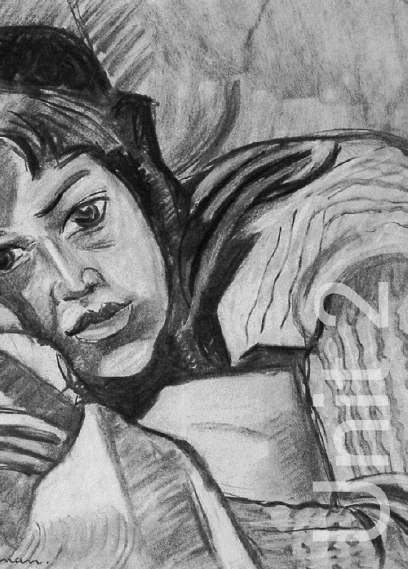UNIT 2A PICTURE THIS!
ABOUT THE UNIT
In this unit children explore an issue or event in their lives. They learn
how to use a viewfinder and record their observations and ideas using a variety
of methods, including photography and collage. They look at and comment on the
work of photographers and illustrators.
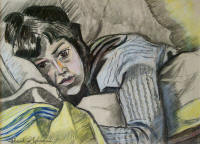
|
Theodore Garman ‘The Sick Child’ (pastel) GR119 (CHILDREN) When were you
ill, what do you do when you’re sick – lie on the sofa watching television,
go to bed, have you been to hospital etc? Each pupil produces a picture
based on their own experiences of sickness or those within their family – a
sister with chicken pox, the doctor’s waiting room – exploring ways of
communicating, recording and exploring ideas based on their own experiences.
|
%20-%201528-1588%20-%20Page%20Boy_small2.jpg)
|
Studio of Veronese ‘Page Boy’ (oil on canvas) GR247 (WORK AND LEISURE) Have you been a pageboy or bridesmaid at a wedding? What celebrations have
you attended, what part did you take in the event, (Christmas, birthdays,
Diwali, christenings, parties)? What did you wear (clothing and costume are very
visual and often children are bought special clothes for a special event). What
would you like to wear for a special party – design an outfit.
|
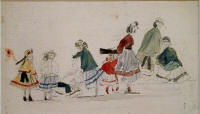 |
Eugene Boudin ‘Figures on a Beach’ (watercolours) GR8 (WORK AND LEISURE) Where do you and your family go out for fun, leisure or on holiday? Visits to
restaurants, friends or relatives evoke memories and strong imagery. Holidays
may involve airports, planes and hotels or possibly caravans, tents or day
trips. Leisure could be out playing football, going swimming, skateboarding,
getting out of the house and doing an activity for fun.
|
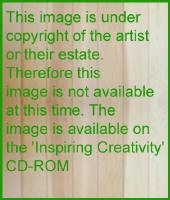
|
Bernard Buffet ‘Small Girl reading a Book’ (oil) GR11 (CHILDREN) |
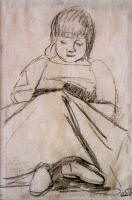
|
George Romney ‘The Little Scholar’ (black chalk) GR209 (CHILDREN) |
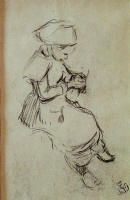
|
Emile Shuffenecker ‘Girl Knitting’ (pencil) GR232 (CHILDREN) |
All these pictures show children involved in a range of activities in a range
of mediums. Ask what the children do in their spare time – television, sport,
computers, toys, look after pets, - pupils’ own choice of leisure activities.
Produce a collage based on their favourite activities.
Pupils can explore events in their lives through art and discover how they
can use everyday occurrences and experiences to provide subject matter for their
artwork. They should also be encouraged to discuss the content of their work and
to look at and discuss the work of illustrators and photographers.
UNIT 2B MOTHER NATURE DESIGNER
ABOUT THE UNIT
In this unit children explore line, shape, colour and texture in natural
forms. They make observations of natural objects and use their observations as
the basis for textile design. They use their experiences of fabrics to make a
collage and learn and use simple techniques for appliqué.
|
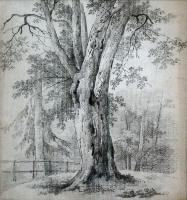
|
Jean-Baptiste Camille Corot ‘Study of a Beech Tree’ (pencil) GR25 (TREES) |
|
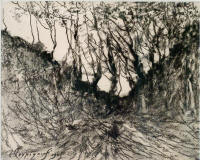
|
Henri-Joseph Harpignies ‘Study of Trees’ (black chalk) GR 137 (TREES) These studies of trees might lead to direct drawing of trees
either looking out of the classroom windows or drawing outside. In spring
changes could be observed through observation of a single tree or bush over time
or by bringing into class cuttings (e.g. from forsythia) and observing and
recording change as twigs bud and flower.
Bark and leaves can be used for printing or rubbings.
Drawings of bark, trees and leaves could be used to develop patterns that can
be used for design work. The linear qualities can be emphasised by asking pupils
to use pen or charcoal.
|
|
%20-%201949_small2.jpg) |
Theodore Garman "Arum Lilies or Easter Flowers’ (oils) GR109 (FLOWERS AND
STILL LIFE)
This is a splendid, colourful study of writhing flowers. Use a viewfinder (a
square or rectangular hole cut out of black paper) to focus on a small area of
the picture and develop a flowing pattern. Take this small area and copy or
trace it to develop a flowing image that can be used to develop a print. This
could lead to links with the American artist Georgia O’Keefe who is known for
her flower painting and to the use of spring flowers as inspiration for designs
for Easter Cards.
|
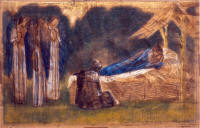
|
Edward Burne-Jones ‘The Nativity’ (Pastel) GR13 (ILLUSTRATION AND SYMBOLISM) This design for a stained-glass window for a church in Torquay could be used
as an introduction to the design work of Burne-Jones (especially his textile
designs) and as a link to William Morris the designer well known for his use of
flowers and animals in both his fabric and wallpaper designs.
|
%20-%20ca%201957-8_small2.jpg)
|
George Ehrlich ‘Head of a Deer’ (bronze) GR47 (ANIMALS AND BIRDS) This sculpture provides a clear, simple silhouette image that
can be used to develop a print or appliqué. The class can use equally simple
designs of other animals or animal heads as the basis of other print ideas. They
may also wish to see the frieze of running deer around the Mochican Head.
|
%20-%20Pottery%20vase%20form%20of%20head%20frieze%20of%20running%20animals_small.jpg)
|
Mochican Head GR335 (ILLUSTRATION AND SYMBOLISM). |
UNIT 2C CAN BUILDINGS SPEAK?
ABOUT THE UNIT
In this unit children explore shape and pattern in buildings. They begin by
producing prints and rubbings of patterns found in buildings and go on to look
at and record, the use of shape, space and pattern in local buildings. They
question how these features tell us something about the purpose of the building.
They work in groups to produce a relief sculpture for temporary display, using
their first-hand observations as a starting point.
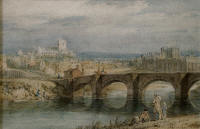 |
Joseph Mallord William Turner ‘Carlisle’ (pen, ink, watercolour) GR245
(LANDSCAPE AND TOWNSCAPE)
Pupils could be asked to look at the picture, listing different types of
buildings – castles, bridge, houses, and cathedral. Pupils could choose some of
these elements to compose their own (romantic) landscape drawn with pen or black
biro. These could be enlarged onto A3 paper and, with pre-mixed washes of
watercolour paint, coloured with transparent washes using large brushes.
The class may then produce an observation picture of a part of the school
using the same techniques. These pictures can be used to consider production of
first-hand observational drawings to record and convey information. Pupils could
develop a play based on 22-year-old Turner’s painting and sketching tour of the
north of England (or your local area - what could he choose to draw etc.)
|
Visit The New Art Gallery and discuss: -
The pattern, colour and variety of materials used, the relief on concrete,
the warmth of colour, pattern and grain of the wood, leather (handrail), metal
(lifts, toilets) glass
The shapes used in the building (inside and outside) and how they interact.
Use of different materials in different areas (also different heights) - wood
in smaller, more intimate room situations, Record these ideas using drawings and
photographs (permission needed for interior). Use these ideas to produce a
relief sculpture of recognisable L shape of exterior in card (from cardboard
boxes) stuck to cardboard base with P.V.A. using newspaper to hinge on to create
windows, doors etc and tiles could be cut from sandstone coloured sugar paper
printed with wax rubbings of patterns found (maybe in art gallery itself).
Make an art gallery sculpture with young children using Duplo (or Lego) or to
make a shallow relief using willow withes covered in white tissue and back-lit.
Ink drawings of the gallery can be enlarged and ‘coloured’ by gluing tissue,
tiles, windows, door shapes over the ‘drawing – achieving a watercolour finish
using tissue paper.
Other buildings
Encourage pupils to look above shops see use of symbols both for decoration
and to say something of what the building stands for. These sort of ideas could
be used as inspiration in the classroom for print making or clay modelling.

Home |
A resource web for art teachers using the Garman Ryan Collection and the
New Art Gallery Walsall, England as a source of inspiration for the delivery of the QCA
National Curriculum 2000 art schemes of work to pupils in Key Stages 1-3 |
